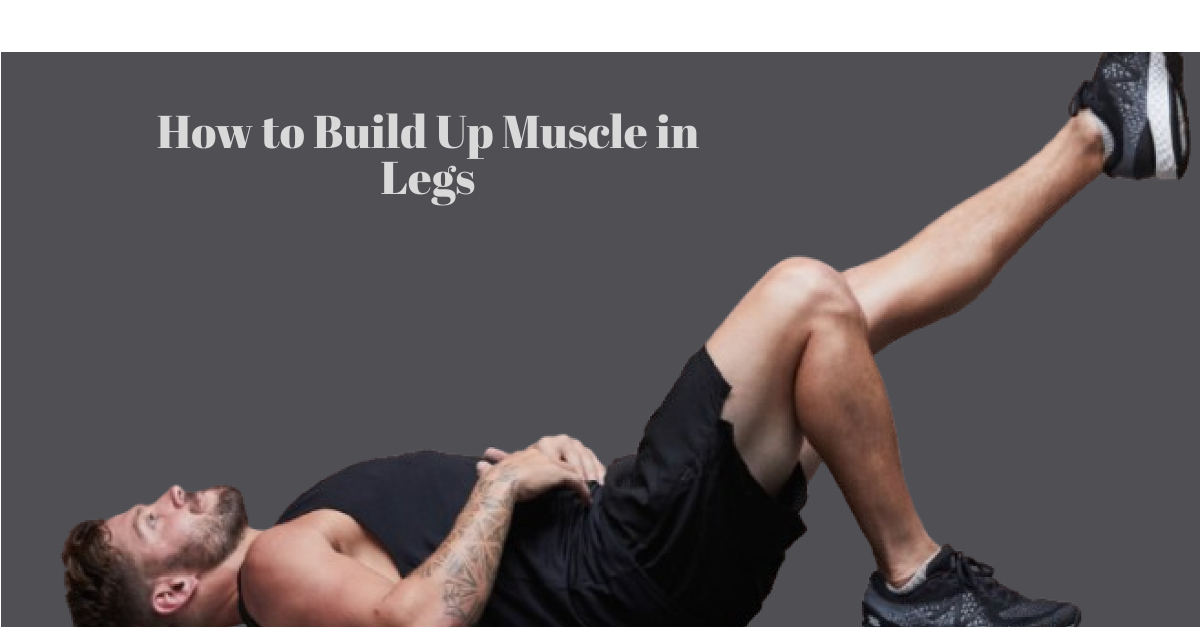How to Build Up Muscle in Legs: Building up muscle in your legs is essential not only for improving your strength but also for achieving a well-balanced, aesthetically pleasing physique. Strong legs are crucial for overall functionality and performance in various physical activities, from sports to everyday movements. Whether you’re aiming to add muscle mass, increase strength, or improve your athletic performance, learning how to build up muscle in your legs requires dedication, the right training techniques, and proper nutrition.

Why Building Muscle in Legs Is Important
Before diving into the “how,” it’s important to understand why building up muscle in your legs is so beneficial. First and foremost, your leg muscles—comprising the quadriceps, hamstrings, glutes, calves, and hip flexors—play a pivotal role in nearly every physical movement. Strong legs not only improve your athletic performance in sports like running, cycling, or jumping but also enhance your stability, balance, and posture.
Building muscle in your legs also leads to increased metabolic rate. Muscles burn more calories even at rest compared to fat, which means that as you build leg muscle, you’ll enhance fat-burning potential across your body. Additionally, well-developed leg muscles can improve mobility and reduce the risk of injury by stabilizing your joints.
How to Build Up Muscle in Legs: Focus on Compound Movements
The key to building up muscle in your legs lies in focusing on compound exercises that target multiple muscle groups. Compound movements engage several muscles at once, enabling you to lift heavier weights and create greater muscle growth.
Squats are the ultimate compound movement for building muscle in your legs. This exercise targets the quadriceps, hamstrings, glutes, and lower back. To perform a squat correctly, stand with your feet shoulder-width apart, lower your hips back and down as if you’re sitting in a chair, and keep your chest lifted. Aim for depth in your squat (thighs parallel to the floor or deeper), and push through your heels to stand back up.
Deadlifts are another excellent compound movement. Although they primarily target the posterior chain (hamstrings, glutes, and lower back), deadlifts also activate the quads and core, contributing to overall leg muscle development. Proper form is essential here, as improper technique can lead to injury. Start with your feet about hip-width apart, bend at the hips to grip the barbell, and then lift it while keeping your back straight and your chest up.
Lunges are another powerful exercise that can help you build muscle in your legs. This unilateral exercise works each leg individually, improving muscular balance. Whether you perform walking lunges, reverse lunges, or stationary lunges, the movement challenges the quads, hamstrings, glutes, and calves.
How to Build Up Muscle in Legs: Incorporate Isolation Exercises
While compound exercises should form the backbone of your leg workout, isolation exercises can complement your routine by targeting specific muscles. By adding these to your workout plan, you can focus on areas that need extra attention, helping to build up muscle in your legs more effectively.
Leg Press: This machine-based exercise focuses on the quadriceps and glutes, though it also engages the hamstrings. The leg press allows you to lift heavy loads, which is key for muscle growth. Set your feet shoulder-width apart on the platform, and push the weight up by extending your legs, keeping your knees in line with your feet.
Leg Curls and Extensions: These exercises are designed to isolate and target specific muscle groups. The leg extension machine focuses primarily on the quadriceps, while the leg curl machine isolates the hamstrings. Both exercises allow for higher repetitions, which can help increase muscle endurance and promote growth.
Calf Raises: Don’t neglect your calves when building up muscle in your legs! Calf raises are an effective way to strengthen the calves, which are often overlooked in leg training. You can perform calf raises using just your body weight or add resistance using a calf raise machine or dumbbells. Make sure to perform the exercise slowly, focusing on the contraction at the top of the movement.
How to Build Up Muscle in Legs: Progressive Overload is Key
One of the most important principles for building up muscle in your legs—or any muscle group—is progressive overload. Progressive overload refers to the gradual increase of weight, reps, or intensity in your exercises over time. This principle challenges your muscles and forces them to adapt and grow stronger, helping you build muscle in your legs.
To implement progressive overload effectively, aim to increase the weight you’re lifting slightly every few weeks. For instance, if you’re squatting 100 pounds for 8 reps, try to add 5-10 pounds after a few weeks and increase your repetitions as well. The goal is to keep pushing your limits and avoid plateauing. Be sure to listen to your body to prevent injury, and prioritize good form over lifting excessively heavy weights.
How to Build Up Muscle in Legs: Training Frequency and Recovery
To maximize muscle growth, consistency is essential. Ideally, you should train your legs 2-3 times per week. This frequency allows for optimal muscle stimulation while giving your body enough time to recover. However, the frequency can vary depending on your individual goals and the intensity of your workouts.
Recovery is just as important as the actual workout itself. Overtraining can lead to injury and muscle fatigue, so make sure to include rest days between leg workouts to allow your muscles to repair and grow. During rest periods, focus on proper nutrition and adequate sleep, which are crucial for muscle recovery.
Nutrition to Support Building Muscle in Legs
Nutrition plays a massive role in your ability to build up muscle in your legs. Without the right nutrients, your body won’t have the energy or building blocks it needs to repair and grow muscle tissue. Here’s what you need to keep in mind:
- Protein: Protein is the most important macronutrient for muscle building. Aim to consume about 1.6 to 2.2 grams of protein per kilogram of body weight each day to maximize muscle growth. Include high-quality protein sources like chicken, beef, fish, eggs, legumes, and plant-based protein powders.
- Carbohydrates: Carbs are your body’s primary energy source. If you’re training hard, your muscles will need glycogen (stored carbohydrates) to fuel your workouts. Include complex carbohydrates like whole grains, fruits, and vegetables in your diet to support your energy needs and recovery.
- Fats: Healthy fats are essential for hormone regulation, which plays a key role in muscle growth. Include sources of healthy fats like avocados, nuts, seeds, and olive oil in your diet.
- Caloric Surplus: To build muscle, you need to be in a slight caloric surplus, meaning you consume more calories than your body burns. However, the surplus doesn’t need to be excessive, as this could lead to unnecessary fat gain. Aim for a surplus of around 200-500 calories per day to support muscle growth without gaining too much fat.
Conclusion: Building Up Muscle in Legs Takes Time and Dedication
Building muscle in your legs is a rewarding process that requires a combination of targeted exercises, progressive overload, proper nutrition, and adequate recovery. By following a well-structured workout plan that incorporates both compound and isolation exercises, you’ll begin to see significant improvements in your leg strength and muscle mass. Remember, consistency is key, and it’s important to stay patient and committed to your goals.
Whether you’re training for aesthetics, strength, or athletic performance, building muscle in your legs will pay off in the form of increased strength, improved mobility, and a more powerful physique. Stay dedicated to your leg workouts, and you’ll be well on your way to achieving strong, defined legs that not only look great but also support your overall fitness journey.

